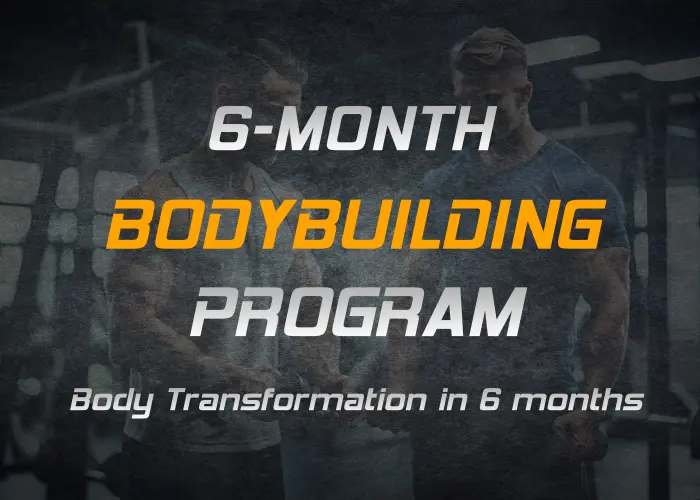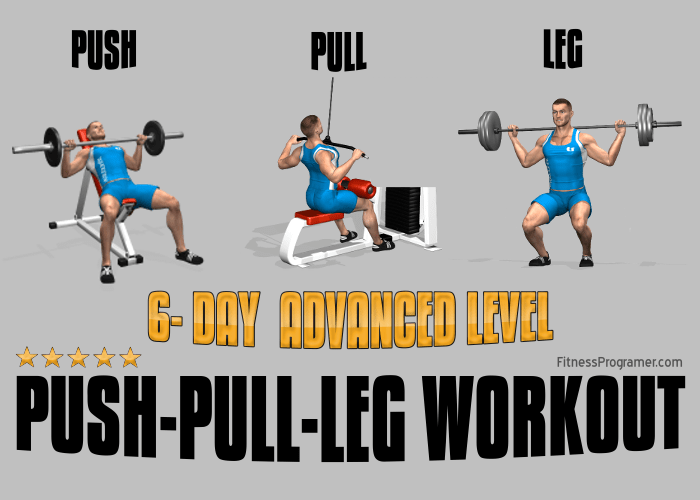Are you ready to fast-track your journey to a stronger, more muscular physique? If you’re someone who’s eager to see significant results within a short time frame and is committed to pushing your limits, this 6-month fast-track bodybuilding program is tailor-made for you.
Prepared by professional trainers, this bodybuilding program is designed to suit participants of all levels. Even those who have never been to the gym before can benefit from this program and make a solid start in bodybuilding.
With a focus on proper form and technique, the program will enable you to gradually increase your weights and enhance your body’s development and strength. Each workout session will be meticulously designed and adapted to challenge you based on the progress you’ve achieved in prior sessions. This way, you can be sure that each workout will push you one step further.
Overview of Bodybuilding Workouts
Workout 1: First 2 weeks for beginners
- The first two weeks of this program have been carefully designed to provide a solid foundation for people with no prior gym experience. The most important goal of the first two weeks is to get used to the exercises by prioritizing correct form rather than lifting heavy weights.
- Given your lack of familiarity with these exercises, it is advisable to execute them at a deliberate pace and with minimal weight.
- By focusing on machine-based exercises, we aim to help you build a foundational level of strength while instilling confidence in your training routine. Our primary goal during this phase is to facilitate essential adaptations, allowing your body to acclimate to unfamiliar exercises.
- These initial two weeks mark the inception of your bodybuilding journey, laying the groundwork for the challenges and growth that lie ahead. As you advance through the program, you will acquire the confidence and proficiency required to transition to more intricate free weight exercises and advanced training techniques.
Workout 1: Week 3 and 4 for beginners
As you continue your bodybuilding journey, it’s time to take the next step and introduce free weights into your routine. Weeks 3 and 4 are crucial stages of your development, as you’ll be transitioning from machine-based exercises to free weights. Free weights engage stabilizer muscles, promoting more balanced and holistic muscle development. This transition is designed to further enhance your strength, improve your mind-muscle connection, and boost your overall confidence in the gym.
Transition Tips:
- Start Light: Begin with lighter weights than you’re accustomed to with machines. Focus on proper form and technique.
- Mind-Muscle Engagement: Pay close attention to how your muscles feel during each movement. Visualize them working throughout the exercise.
- Gradual Progression: As you become more comfortable with free weights, gradually increase the weights while maintaining good form.
- Stay Patient: Free weights may feel more demanding initially, but this challenge is where the true growth occurs.
Workout 2: 10-Week PPL Split Routine
This is where the 6-day PPL (Push-Pull-Legs) split training comes into play, propelling your development even further.
Why the 6-Day PPL Split:
- Targeted Muscle Groups: The PPL split dedicates each day to specific muscle groups, allowing focused and intense training for optimal muscle development.
- Frequency: Training muscle groups twice a week enhances muscle growth potential through increased frequency.
- Variety and Volume: The split provides the opportunity to include a variety of exercises and higher training volume, stimulating muscle growth and overall strength.
- Advanced Technique: By this point, you’re familiar with exercises and have developed good form, making you ready for the challenges of the PPL split.
Progressive Overload: As you become stronger and more proficient with your exercises, gradually increase the weight you’re lifting to continue challenging your muscles. Pay attention to how your body responds to the weight you’re lifting. It’s normal to experience some discomfort and fatigue during workouts, but avoid pushing yourself to the point of pain or risking injury.
Workout 3: 10-Weeks Bodybuilding Program
Now, as you embark on a more realistic workout routine, it’s time to gradually increase the weights. This progressive approach ensures that your muscles are continually challenged, promoting strength development and muscle growth. By pushing your limits within reason, you stimulate further adaptation and progress.
As you begin this phase of the program, consider gradually increasing the weights to challenge your muscles and encourage the development of hypertrophy.
If you’re unsure which weights are right for you, sample 1-2 sets with 8-12 repetitions beforehand. If you can easily lift two sets at 12 reps, go heavier. In the case that the weights are slightly challenging for you, stick to them.
What should I do before I start training?
Warm-Up: Begin with a dynamic warm-up routine to increase blood flow to your muscles, elevate your heart rate, and prepare your body for the upcoming physical activity. Dynamic stretches and light cardio exercises like jogging, jumping jacks, or skipping rope are excellent options for warming up.
Nutrition: Fuel your body with a balanced meal or snack containing carbohydrates, protein, and healthy fats. Consuming carbohydrates provides energy for your workout, while protein supports muscle repair and growth.Timing-wise, aim to consume your pre-workout meal or snack about 1–2 hours before your training session to allow for digestion and absorption of nutrients.
Hydrate: Proper hydration is essential for optimal performance and helps prevent dehydration, fatigue, and muscle cramps during exercise.
Caloric Intake, macros and supplements
- Caloric Surplus: Aim for an energetic diet with approximately a 10-20% calorie surplus. Novice and intermediate bodybuilders can target a weekly weight gain of around 0.25–0.5% of body weight, while advanced bodybuilders should be more conservative with their surplus and weight gain goals.
- Protein Intake:
- Total daily intake: 1.6–2.2 grams per kilogram of body weight.
- Meal distribution: Aim for 0.40–0.55 grams per kilogram of body weight per meal.
- Spread protein intake evenly throughout the day, aiming for 3–6 meals.
- Consume protein within 1–2 hours pre- and post-training sessions for optimal muscle protein synthesis.
- Fat Intake:
- Moderate fat consumption is recommended, ranging from 0.5–1.5 grams per kilogram of body weight per day.
- Carbohydrate Intake:
- Ensure adequate carbohydrate intake to support energy demands from resistance exercise. Aim for at least 3–5 grams per kilogram of body weight per day from carbohydrates.
- Supplements:
- Creatine Monohydrate: 3–5 grams per day. Creatine can enhance strength and muscle mass gains.
- Caffeine: 5–6 milligrams per kilogram of body weight. It can improve focus, energy, and performance during workouts.
- Beta-Alanine: 3–5 grams per day. It may improve endurance and delay muscle fatigue.
- Citrulline Malate: 8 grams per day. It could enhance exercise performance and reduce fatigue.
These recommendations are grounded in scientific literature and aim to support natural bodybuilders in effectively increasing muscle mass during the off-season phase while optimizing their nutritional intake and supplementation (1). However, individual needs may vary, so it’s important for bodybuilders to listen to their bodies and potentially consult with a nutritionist or dietitian to tailor their nutrition plan to their specific goals and requirements. Additionally, staying hydrated and getting enough micronutrients are also crucial for overall health and performance.
Bodybuilding Program For Begginers
Bodybuilding Workout Program 2
Bodybuilding Workout 3
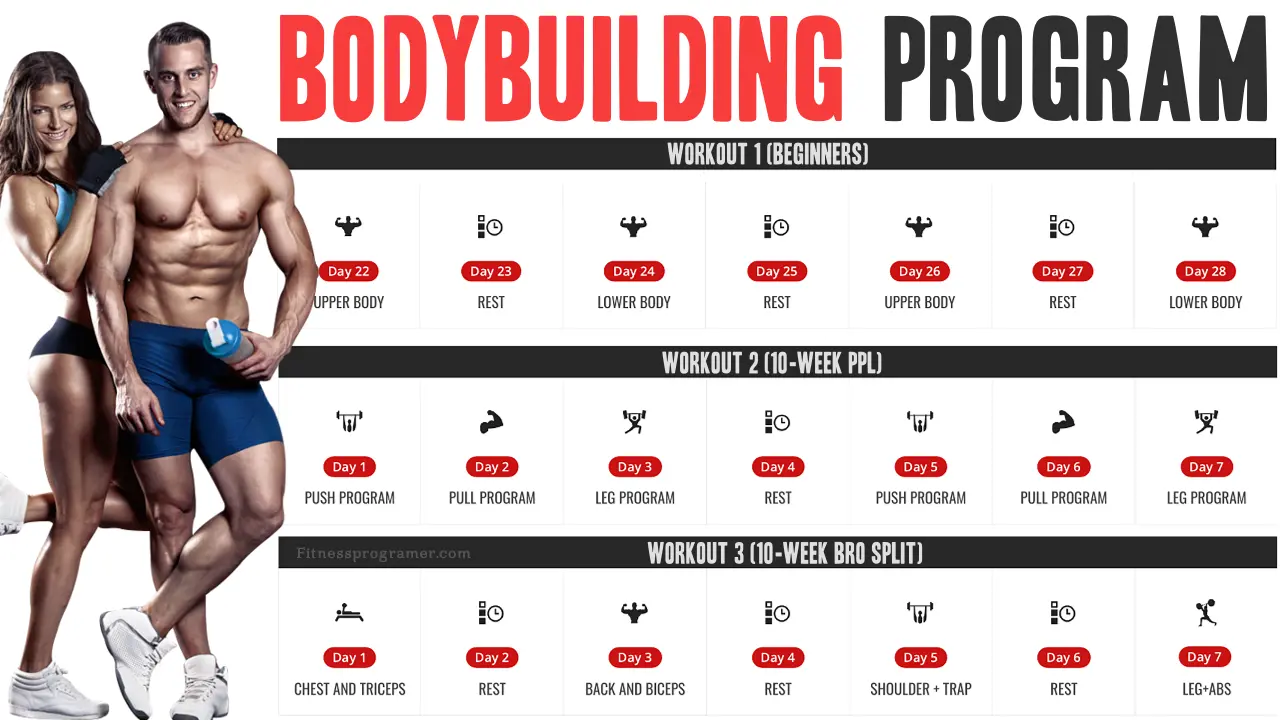
3×5 Workout Program
A 3×5 Full Body Strength Training Program is a simple yet effective way to build a solid foundation of strength. This program typically involves performing three sets of five repetitions for each exercise. The focus on compound movements ensures that multiple muscle groups are engaged, leading to better overall strength gains.
Level:
This program is for beginners or for people who have been lifting weights but have never focused on building a strength base first. Most everyone should start with this program as most people never started weight training properly. Once you learn proper form and begin to take your strength to new levels, you will be amazed at the changes in your body and your life. All sets for a given exercise are done with the same weight. For example, you would do squats with the same weight for all 3 sets. You would then change the weight and do bench press with the same weight for all 3 sets.
Workout Details
There are 2 different weight lifting workouts in this program that you will rotate throughout the schedule. This program only includes the best overall weight lifting exercises and does not need any other exercises added. Just stick with these, and you’ll see why you don’t need any other exercises for this workout program.
Workout Schedule
The workout schedule will be 3 days per week with 4 days of rest. Each workout has at least 1 day of full rest between workouts. This is the optimal weight lifting schedule for building muscle that allows proper rest and recovery between workouts.
Week 1 Workout Schedule
- Week 1, Day 1 = Workout A
- Week 1, Day 2 = Off
- Week 1, Day 3 = Workout B
- Week 1, Day 4 = Off
- Week 1, Day 5 = Workout A
- Week 1, Day 6 = Off
- Week 1, Day 7 = Off
Week 2 Workout Schedule
- Week 2, Day 1 = Workout B
- Week 2, Day 2 = Off
- Week 2, Day 3 = Workout A
- Week 2, Day 4 = Off
- Week 2, Day 5 = Workout B
- Week 2, Day 6 = Off
- Week 2, Day 7 = Off
Warm-up
Always start with a proper warm-up before each workout. This can include light aerobic activity, mobility exercises, and dynamic stretches for the major muscle groups you’ll be working that day.
Start Weights
Start with extra light weights because you need to take your time learning proper form and technique on all of the 7 different exercises within this program. Do not not start out with heavy weight or weight that gives you any trouble for the first few weeks. You have plenty of time to increase the weight and the workouts will become very tough just a short time down the road. So spend your time now with light weights and ensure your form is good before moving up in weight.
Plan of Progression
(Squat, Bench, Row, Press) Once you get all 3 sets of 5 reps each set with a given weight with good form and technique, it’s time to increase the weight for the next workout by 2.5%. (Deadlift) If you get all 5 reps with good form and technique, increase the weight by 2.5% for the next workout. (Dip and Chin Up) Once you get to 8 reps, it’s time to begin adding weight with a weight belt. Add 2.5 pounds once you reach 8 reps with a given weight.
Stalling and What to Do
You are officially stalling on an exercise if you haven’t been able to increase the weight in 3 consecutive workouts. Once this happens on any exercise, reset that exercise only by decreasing the weight by 10%. Continue increasing the weight by 2.5% each workout on that exercise. It will take 4 workouts to get back to where you were but you should be able to surpass your previous weights.
When to Stop This Program
Once progress stalls for the third time on either squats or deadlifts, it’s time to stop the program. No more resets. This means you have 2 chances to reset squats or deadlifts. When it’s time for the third reset on either exercise, it’s time to stop the program. Reset the other exercises as many times as needed. As long as you are making progress on squats and deadlifts, you must continue this program. The squat and deadlift are the most important exercises and are treated as such. This program should last for several months. Your goal should be to stick with this program as long as possible.
Intensity Level
You should not be anywhere near failure for any set of any exercise for at least 3 to 4 weeks. As you continue through this program, your strength will continue to increase and you shouldn’t have to go to failure for a long period of time. As the weight continues to increase and you get closer to stalling, you will automatically increase the intensity in an attempt to get all your reps for each set. You will get closer to failure and will probably go to complete failure every once in a while. But for the large majority of this program, you will not be going to failure.
Workout Overview
A toned appearance is the product of low body fat levels combined with muscular definition. A body toning workout for women typically involves exercises that target various muscle groups to increase muscle definition, strength, and overall body tone. The following workout routine incorporates both strength training and cardio exercises to help you achieve your body toning goals.
| Workout Type | Split |
| Program Duration | 6-8 Weeks |
| Workout Goal | Weight loss, strength and toning |
| Levels | Beginners |
| Equipment | Exercise ball, Jump Rope, Resistance Band |
| Frequency | 6 Days per Week |
Equipment and Workout
Exercise Ball: The exercise ball is a versatile piece of equipment that can be used for a wide range of exercises, targeting different muscle groups. The workout plan consists of eight exercises, each strategically selected to engage multiple muscle groups and challenge your core stability.
Jump rope: Jump rope is a fantastic cardio exercise that can help improve your coordination, endurance, and overall fitness. The workout is designed to be performed in circuit style with minimal rest between sets to maximize calorie burn and increase cardiovascular endurance.
Resistance band: Resistance bands are effective tools for body tightening and strength training. They offer several benefits that make them a popular choice for individuals of all fitness levels. Incorporating a mix of bodyweight exercises and resistance band movements, this workout will help you achieve a well-defined and toned body.
Here are some steps to help you get started:
Warm-up: Start with a 5-10 minute warm-up to get your blood flowing and prepare your muscles for exercise. You can do light cardio activities such as jogging in place, jumping jacks, or cycling.
Body Toning Workout: Perform each exercise for the specified number of repetitions or time, depending on your fitness level. If you’re a beginner, start with lower repetitions and gradually increase them as you progress. This will help prevent injuries and allow your body to adapt to the new demands of exercise.
Cool Down: Finish with a 5-10 minute cool down, which may include static stretching for the major muscle groups you worked during the workout.
Manage Your Caloric Intake: Achieving a toned and sculpted physique involves more than just exercise; proper nutrition plays a crucial role in supporting your fitness goals. To tone your body, you’ll need to create a caloric deficit by consuming fewer calories than you burn. However, ensure that you’re still meeting your body’s energy needs to support workouts and daily activities. Focus on nutrient-dense, lower-calorie foods to help you stay satisfied.
Workout Description
The advanced workout plan below is a 5-day split. This means that you will perform five circuits on five different days of the week, each targeting different muscle groups. Typically, most of our reps lie between 10 and 12 to help maximize hypertrophy. All the workouts are muscle gain and muscle-strengthening exercises.
This workout is designed to increase your muscle mass as much as possible in 6-8 weeks. Works each muscle group hard once per week using mostly heavy compound exercises. To train with this program, click the green save button below. Thus, when you go to training, you can open this program that you have registered on your profile page and perform the movements in the correct form.
Nutrition is very important as this workout plan is an advanced routine. Don’t forget to feed your muscles with a balanced diet that contains enough protein.
- Eat high-quality protein with every meal
- Eat plenty of green vegetables with at least 3 of your meals
- Eat fruits with protein post-workout
- Eat complex carb sources, such as oatmeal, sweet potatoes, and whole grains throughout the day for energy
- Keep your calories high enough to give you energy and for muscle growth
HOW MUCH WEIGHT SHOULD I LIFT?
For Muscle Development, lift 70-85% of the maximum weight you can lift, apply at intervals of 8-12 repetitions, and apply a 45-60 second rest period. Try to increase the weight a little more each time you go to training.
One-rep-max is a measure of the amount of weight you can lift for a particular exercise for one repetition. It is often calculated using a one-rep-max calculator where you can input your max weight lifted for multiple reps and it will provide you with an equivalent one-rep-max estimate. For instance, the amount of weight you can lift to fatigue for 8 repetitions is approximately 80% of your one-rep-max.
5×5 Workout Program
The 5×5 workout plan offers many benefits when it comes to maximizing your overall growth and development in the gym. The low number of repetitions means you’ll be lifting very heavy weights relative to your current strength level and body size. This heavy training teaches your nervous system to maximally recruit each muscle fiber, meaning you can produce more force with the same muscle fibers over time. The goal is to build strength in compound movements by adding weight every time you do the workout.
For optimal gains, you should base your program on a 1 repetition maximum (1RM). Calculate Your One Rep-Max (1RM) For 5 reps, you should be roughly able to lift 70-80% of your 1RM. Start with low weight for the first 2 weeks — or just the bar if you’re a beginner. After each 2-week cycle, add 2,5-5 kg to the squat and deadlift and 2,5-5 kg to upper body exercises. You’ll only do these workouts 3 times a week, as the rest days in between workouts are crucial to encouraging muscle growth.
Before starting the training, make sure to do warm-up exercises. The proper way to warmup is to start with two sets of five with the empty bar. Add 10-20kg/25-45lb and do your next warmup set for 2-3 reps. If you want to create a warm-up routine for yourself, remember that there are many warm-up and stretching exercises on fitnessprogramer.com.
Frequently Asked Questions about the 5x5 Workout:
What is a 5x5 workout?
A 5×5 workout is a strength training program where you perform 5 sets of 5 repetitions for each exercise. It focuses on compound movements like squats, deadlifts, bench presses, overhead presses, and rows to build overall strength and muscle mass.
Who is the 5x5 workout suitable for?
The 5×5 workout is suitable for individuals of various fitness levels, from beginners to experienced lifters. It’s especially beneficial for those looking to build strength, improve muscle mass, and enhance overall athleticism.
What are the main benefits of a 5x5 workout?
The main benefits include increased strength, muscle mass, and overall fitness. Additionally, the simplicity of the program makes it easy to follow, and the focus on compound movements ensures efficient muscle development.
How often should I do a 5x5 workout?
It is typically recommended to do a 5×5 workout three times a week on non-consecutive days, allowing for proper rest and recovery between sessions. This frequency provides enough stimulus for strength gains without risking overtraining.
Can I customize the 5x5 workout program?
Yes, the 5×5 workout can be customized to suit individual goals and preferences. You can adjust the weight, choose variations of exercises, or add accessory exercises to target specific muscle groups or weaknesses.
How do I progress in a 5x5 workout program?
Progression in the 5×5 workout typically involves increasing the weight lifted gradually over time as you get stronger. Aim to add weight to the bar in small increments, such as 2.5 to 5 pounds, whenever you can complete all sets and reps with good form.
What should I do if I plateau on a 5x5 workout?
If you plateau on a 5×5 workout, consider implementing techniques such as deloading, varying rep ranges, or changing exercises to overcome the plateau. Additionally, ensuring proper nutrition, rest, and recovery is crucial for continued progress.
Is the 5x5 workout suitable for fat loss?
While the primary focus of the 5×5 workout is on building strength and muscle mass, it can contribute to fat loss indirectly by increasing metabolism and promoting muscle growth, which helps burn more calories even at rest.
How long does a 5x5 workout session typically last?
A 5×5 workout session usually lasts around 45 minutes to an hour, including warm-up sets, the main lifts, and any additional accessory exercises or stretching.
Can I combine the 5x5 workout with other forms of exercise?
While the 5×5 workout can be the cornerstone of your strength training routine, it can also be complemented with other forms of exercise such as cardiovascular training, flexibility work, or specific sports training depending on your overall fitness goals. Just ensure proper recovery and avoid overtraining.
Are there any risks associated with the 5x5 workout?
Like any strength training program, there are potential risks of injury if proper form is not maintained or if you progress too quickly with heavy weights. It’s essential to start with light weights, focus on technique, and gradually increase intensity to minimize the risk of injury.
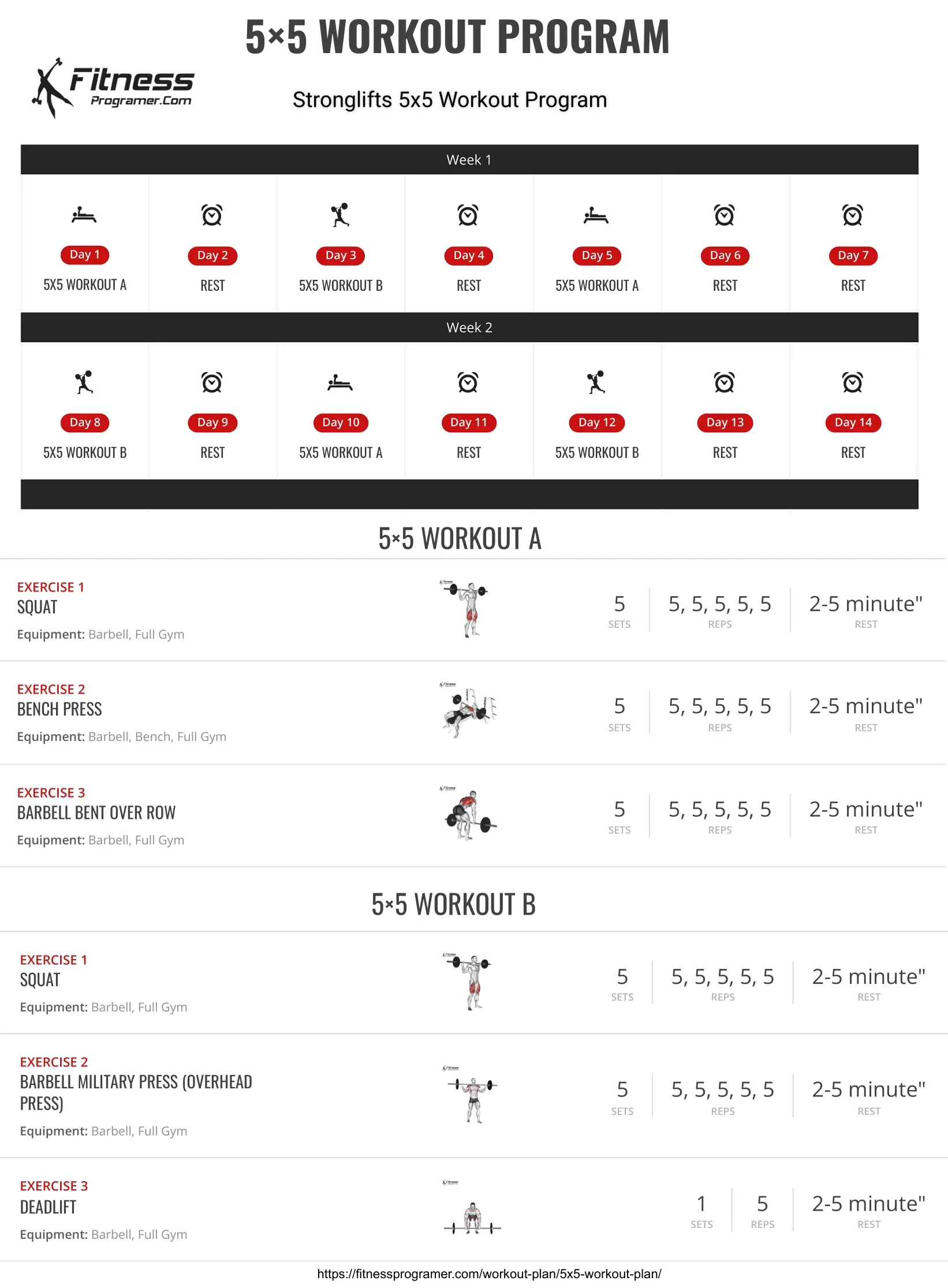
Workout Description
Push-pull-legs (PPL) is a muscle build training split that divides your muscles into groups, where each group is trained separately, on a different day. This 6 day push/pull/legs workout routine split is a high volume, workout system designed for advanced lifters looking to gain muscle and strength. This workout plan allows you to train each muscle twice a week. And doing that will help you build increase muscle mass and strength both.
In this training program, some weightlifting exercises are replaced by dumbbell and cable exercises to emphasize deeper muscles.Also, since some exercises are based on the pyramid system, the weights need to increase as the number of sets decreases.
When you’re training hard and heavy, your diet is just as important for muscle growth and recovery. So it’s important to have a solid meal plan.
- Eat high-quality protein with every meal
- Eat plenty of green vegetables with at least 3 of your meals
- Eat fruits with protein post-workout
- Eat complex carb sources, such as oatmeal, sweet potatoes, and whole grains throughout the day for energy
- Keep your calories high enough to give you energy and for muscle growth (you will burn a ton of calories with these types of workouts, especially if you do the 6-day push-pull legs routine)
Push workouts: chest, shoulders, and triceps
Pull workouts: back, biceps, wrist and forearm
Legs workouts: quadriceps, hamstrings, glutes, and calves
| Routine Type | Split |
| Program Duration | 4-8 Weeks |
| Routine Goal | Hypertrophy And Strength |
| Training Level | Intermediate to Advanced |
| Duration Per Session | 60-90 Minutes |
| Frequency | 6 Days per Week |
| Gender | Male and Female |
| Supplements | Protein, Amino acid, Creatine, |
Advanced Powerlifting Program
This is a 8-week advanced powerlifting program for peaking! So, the focus will be on peaking for your next powerlifting competition or meet! Use the calculator below for any lift to estimate your one-rep max based on the amount of weight you can lift on a given move, and the number of clean reps you can achieve before muscle failure.
To train with this program, click the green save button below. Thus, when you go to training, you can open this program that you have registered on your profile page and perform the movements in the correct form.
| Exercise | Load |
| Bench Press Narrow Grip Bench Press Military Press Lateral Raise Lying Triceps Pushdowns Incline Sit-up | Heavy Auxiliary Auxiliary Auxiliary Auxiliary Abdominal |
| Exercise | Load |
| Squat Deadlift Wt Chin-ups CB Seated Row Seated Leg Curl Hammer Arm Curl | Heavy Light Auxiliary Auxiliary Auxiliary Auxiliary |
| Exercise | Load |
| Bench Press Wide Grip Bench Press Wt Triceps Dip Upright Row One Arm Shoulder Press Incline Leg Raise | Light Auxiliary Auxiliary Auxiliary Auxiliary Abdominal |
| Exercise | Load |
| Deadlift Squat Wt Pull-ups LV Seated Row Lying Leg Curl Arm Curl | Heavy Light Auxiliary Auxiliary Auxiliary Auxilary |
| Core Lifts | Auxillary Lifts | |||||||
| Period/Week | Heavy | Light | Auxillary | Abdominal | ||||
|---|---|---|---|---|---|---|---|---|
| Sets | Reps | Sets | Reps | Sets | Reps | Sets | Reps | |
| Off Season | 4 | 5-7 | 3 | 8-10 | 3 | 8-10 | 2 | 15-20 |
| 1 | 4 | 5-6 | 3 | 7-8 | 3 | 6-7 | 2 | 10-15 |
| 2 | 4 | 4-5 | 3 | 6-7 | 3 | 8-10 | 2 | 15-20 |
| 3 | 4 | 3-4 | 3 | 5-6 | 3 | 6-7 | 2 | 10-15 |
| 4 | 4 | 2-3 | 3 | 4-5 | 3 | 8-10 | 2 | 15-20 |
| 5 | 5 | 4-5 | 5 | 6-7 | 4 | 6-7 | 3 | 10-15 |
| 6 | 3 | 3-4 | 3 | 5-6 | 3 | 8-10 | 2 | 15-20 |
| 7 | 0-1 | 2-3 | 0-1 | 4-5 | 0-1 | 6-7 | 0-1 | 10-15 |

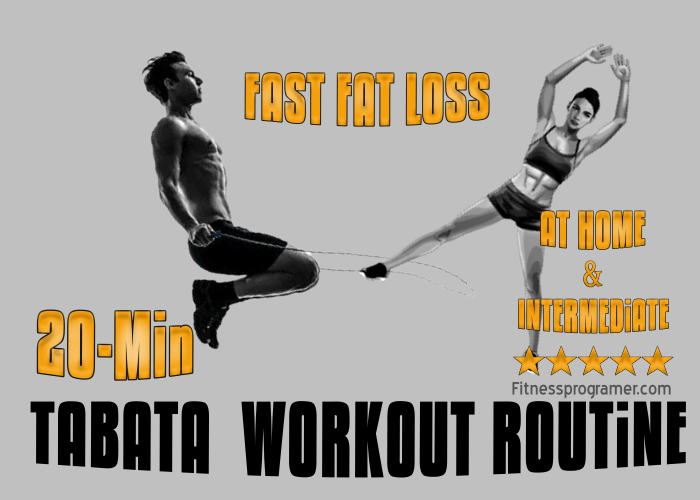
Tabata is a form of high-intensity interval training (HIIT) that has been proven to quickly burn excess calories. This tabata training program may not be suitable for beginners, but if you are still interested in tabata training, you can try to do these exercises in order without time constraints, then speed up the training.
For each exercise, do eight rounds of 20 seconds of exercise followed by 10 seconds of rest. Rest for 1 minute between each round. You can do the exercises in sequence or in one round.
Samp:
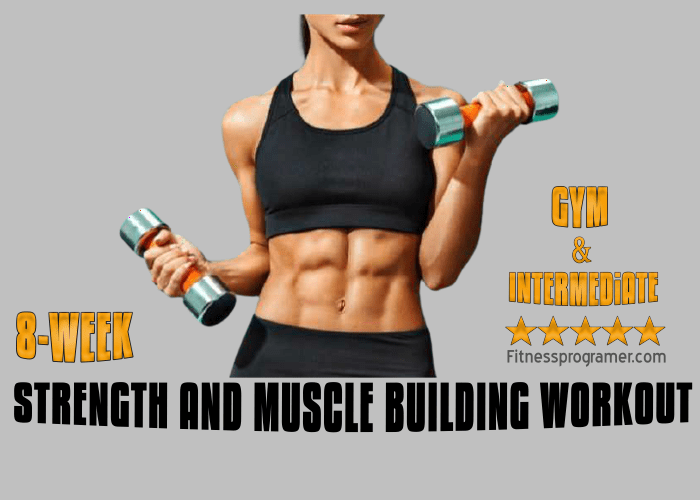
This workout program is designed to lose fat, gain muscle and strength. The workout itself targets your lower body three times a week with a strong focus on your glutes, and your upper body twice a week with a focus on sculpting the muscles of the arms. To train with this program, click the green save button below. Thus, when you go to training, you can open this program that you have registered on your profile page and perform the movements in the correct form.
WARMING UP AND STRETCHING
Warm-up helps prepare your body for aerobic activity. Because the main purpose of warming is to prepare your whole body for training. With a proper warm up exercise and stretching routine the elasticity and flexibility of the tendons and ligaments are increased. Warm-up and stretching is an activity that does not take much time, even a 10-15 minute stretching routine will help you avoid injury. For this reason, before starting any exercise program, warm-up movements and then stretching movements should be done.
Nutrition
The daily calorie intake calculator will help you calculate the number of calories you should consume in line with your goals. If your goal is to lose weight, calculate the number of calories you should consume by selecting the weight loss section. If your goal is to build muscle, choose the muscle building part.

This workout combines both powerlifting and bodybuilding styles, aiming to develop muscle while getting stronger.
Your strength training days consist of low sets and reps. Most moves aim for 2-3 sets of 4-6 reps. This means that each set will contain a lot of challenges. Using 85%-100% of your maximum weight in strength training is the best way to increase your physical strength.
START WITH WARM-UP AND STRECHING
Warm-up helps prepare your body for aerobic activity. Because the main purpose of warming is to prepare your whole body for training. With a proper warm up exercise and stretching routine the elasticity and flexibility of the tendons and ligaments are increased. Warm-up and stretching is an activity that does not take much time, even a 10-15 minute stretching routine will help you avoid injury. For this reason, before starting any exercise program, warm-up movements and then stretching movements should be done.
How Much Weight Should I Lift?
For Strength Training, use 85-100% of your maximum weight with 1-5 reps. Practice your workout by resting for 3-5 minutes. eg. In the program with 5-3-1 set number, lift 85% weight in 5th repetition, 90% weight in 3 repetitions, and 100% weight in the last repetition by giving all your strength.
For Muscle Development, lift 75-85% of the maximum weight you can lift, apply at intervals of 8-12 repetitions, and apply a 45-60 second rest period. Try to increase the weight a little more each time you go to training.
One-rep-max is a measure of the amount of weight you can lift for a particular exercise for one repetition. It is often calculated using a one-rep-max calculator where you can input your max weight lifted for multiple reps and it will provide you with an equivalent one-rep-max estimate. For instance, the amount of weight you can lift to fatigue for 8 repetitions is approximately 80% of your one-rep-max.

